
Photo from wikipedia
Introduction Ustekinumab (UST) is a human IgG1 kappa mAb to the shared p40 subunit of IL-12 and IL-23 which are involved in TH1 and TH17 mediated pathways of Crohn’s disease… Click to show full abstract
Introduction Ustekinumab (UST) is a human IgG1 kappa mAb to the shared p40 subunit of IL-12 and IL-23 which are involved in TH1 and TH17 mediated pathways of Crohn’s disease (CD) pathogenesis. NICE approved UST for CD in April 2017, but there is limited UK data on real-world effectiveness. We present clinical effectiveness, safety and drug persistence data from a complex UK cohort. Methods This was a retrospective observation cohort study of all CD patients treated with UST outside clinical trials in a single UK IBD centre. Physician’s global assessment (PGA) was recorded at baseline, post induction and 1 year. Primary outcome was clinical response defined by a fall in PGA. Secondary outcomes were drug persistence and fall in CRP or faecal calprotectin (FC). Statistical analysis was performed by Wilcoxon signed rank test in R v.3.4.4. Results 84 patients (mean age 42 years, sd 14.7, mean disease duration 12.3 years, sd 8.9) were treated to December 2018. 82 (98%) had previous exposure to anti-TNF therapy, 35 (42%) to both anti-integrin and anti-TNF and 2 were naïve to biologics. 39 (46.4%) were on immunodulator co-therapy and 6 (7%) on steroids. Post-induction treatment was 12 weekly (9), 8 weekly (74) or 6 weekly (1). Post-induction (median 14.7 weeks, IQR 8.03) and 1 year (median 44.4 weeks, IQR 13.4) reviews were availiable for 72 and 47 patients respectively. Post-induction clinical response occurred in 38 (53%) and remission in 5 (7%). At 1 year response occurred in 34 (72%) and remission in 7 (15%). Of 15 non-responders post induction left on UST, 9 responded by 1 year. Steroid-free response occurred in 35 (48%) post-induction and 31 (65%) at 1 year. By 1 year 8 patients stopped UST (median 256 days, range 62–329); 1 cutaneous reaction, and 7 primary non-response or secondary loss of response. Only 1 of 8 given a second intravenous dose in an attempt to recapture response had a sustained benefit. For those with an elevated biomarker at baseline (CRP >10 or FC >250) and repeat meaurement post induction, mean CRP improved from 37 (11–96) to 28 (3.8–116) (p=0.074) and FC 2260 (292–6000) to 1152 (24–5084) (p=0.089). For paired results at baseline and 1 year mean CRP improved from 29 (11–96) to 19 (3–77) (p=0.045) and mean FC 2019 (823–6000) to 1070 (42–5528) (p=0.011). There was no significant change in normal baseline biomarkers. Conclusions UST was well tolerated in a complex UK CD cohort and demonstrated benefit in terms of clinical response, improvement of biomarkers and in some full clinical remission. Due to delayed response continuation beyond 3 months is justifiable in some non-responders. Reloading to recapture response as described elsewhere was of limited benefit.
Journal Title: Gut
Year Published: 2019
Link to full text (if available)
Share on Social Media: Sign Up to like & get
recommendations!